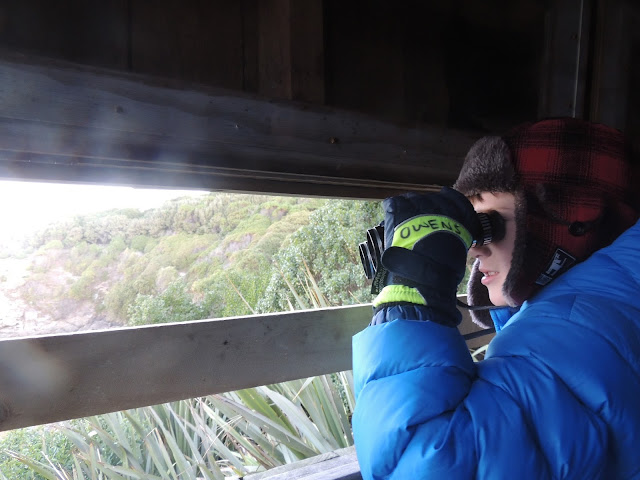The drive in late-afternoon winter light was worth it alone
New road sign for the collection as we moved to gravel
There's a functioning lighthouse at Katiki Point, though you can't approach it. Its light shined for the first time on April 22, 1878. It was built following several accidents on the dangerous reefs.
To one side of the lighthouse is a narrow path leading to a blind where you can view the yellow-eyed penguins. The blind itself is a wooden structure, quite small, with slats for viewing without disturbing them. You're also asked to keep quiet. On first glimpse, we can see their starched white tuxedo shirts. And there are lots of them!
We shared the blind with a friendly NZ family.
Good info at this site, liberally quoted here.
Hoiho - the noisy penguin
The yellow-eyed penguin (Megadyptes antipodes) is only found in New Zealand is one of the rarest of our penguins. They live and breed around the south-east coast of the South island, on Stewart island and in the sub-antarctic Auckland and Campbell islands. They are known to Maori as Hoiho
(Ed note: literally, noise shouter, and we could hear them).
Physical characteristics
Standing 65 cm tall and weighing 5 to 6 kg, the yellow-eyed is the fourth
largest of the world's penguins. The distinguishing feature of the yellow-eyed
penguin is its distinctive yellow eye and bright yellow stripe that runs
through the eye and around the back of the head. Both sexes are alike,
although the male does have slightly larger head and feet. My head almost exploded as I zoomed in. What a privilege to see these rare birds in their own environment.
Habitat
Yellow-eyed penguins are forest or shrubland nesting birds, usually preferring to nest in a secluded site and backed up to a bank, tree or log. Although they nest in loose "colonies", yellow-eyed penguins do not nest within sight of each other.
Yellow-eyed penguins are forest or shrubland nesting birds, usually preferring to nest in a secluded site and backed up to a bank, tree or log. Although they nest in loose "colonies", yellow-eyed penguins do not nest within sight of each other.
They just kept marching in from the sea
Breeding
Nest sites are selected in August and normally two eggs are laid in September. The incubation duties (lasting 39-51 days) are shared by both parents who may spend several days on the nest at a time. For the first six weeks after hatching, the chicks are guarded during the day by one parent while the other is at sea feeding. The foraging adult returns at least daily to feed the chicks and relieve the partner.
After the chicks are six weeks of age, both parents go to sea to supply food to their rapidly growing offspring. Chicks usually fledge in mid February and are totally independent from then on. Chick fledge weights are generally between 5 and 6 kg. First breeding occurs at 3-4 years of age and long term partnerships are formed. Yellow-eyed penguins may live for up to 24 years
Nest sites are selected in August and normally two eggs are laid in September. The incubation duties (lasting 39-51 days) are shared by both parents who may spend several days on the nest at a time. For the first six weeks after hatching, the chicks are guarded during the day by one parent while the other is at sea feeding. The foraging adult returns at least daily to feed the chicks and relieve the partner.
After the chicks are six weeks of age, both parents go to sea to supply food to their rapidly growing offspring. Chicks usually fledge in mid February and are totally independent from then on. Chick fledge weights are generally between 5 and 6 kg. First breeding occurs at 3-4 years of age and long term partnerships are formed. Yellow-eyed penguins may live for up to 24 years
Diet and feeding
Yellow-eyed penguins feed on a variety of fish including opal fish, silverside, sprat, aruhu and red cod. Arrow squid is also important in their diet. Feeding is usually done near the bottom, at depths of up to 160m and as far as 50km off shore. Dive times are up to 3.5 minutes.
The loss of coastal forest has played a part in the decline of the yellow-eyed penguin on the NZ mainland, but the biggest threat to the survival of the species is introduced mammalian predators. Wild cats, ferrets and stoats often kill chicks and take eggs. Adult penguins all too often fall victim to dogs.
Fancy a drink?
Population and conservation status
The population of yellow-eyed penguins is estimated to be around 2,000
breeding pairs and is centred on the sub-antarctic Auckland and Campbell
Islands, however around 500 pairs breed on New Zealand's South Island
and another 150 pairs on and around Stewart Island. Variable marine productivity
causes considerable fluctuation in year-to-year numbers of breeding pairs,
however the long-term trend is stable. The species is listed by the NZ
Dept of Conservation as being "Threatened".It was quite a moment. And on the five-minute drive back to camp, a quintessential NZ sight unfolded before us on the gravel road.
Sheep don't apparently like anyone/anything coming toward them, least of all a Land Rover. They hurried out of the road.




















No comments:
Post a Comment